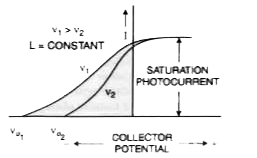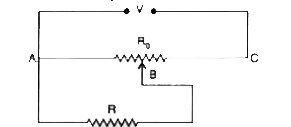Draw a plot showing the variation of potoelectric current with collector plate potential for two different frequencies, v1>v2, of incident radiation having the same intensity. In which case will the stopping potential be hgiher ? Justify your answer.Solution in Kannada

Stopping potential is more for the corresponding to frequency v2.
Stopping potential is directly proportional to the frequency of incident radiation.
Topper's Solved these Questions
- DUAL NATURE OF RADIATION AND MATTERBOOK - OSWAAL PUBLICATIONCHAPTER - DUAL NATURE OF RADIATION AND MATTEREXERCISE - TOPIC-1 PHOTOELECTRIC EFFECT (LONG ANSWER TYPE QUESTIONS)
4 Videos
- DUAL NATURE OF RADIATION AND MATTERBOOK - OSWAAL PUBLICATIONCHAPTER - DUAL NATURE OF RADIATION AND MATTEREXERCISE - TOPIC-1 PHOTOELECTRIC EFFECT (NUMERICAL PROBLEMS)
15 Videos
- DUAL NATURE OF RADIATION AND MATTERBOOK - OSWAAL PUBLICATIONCHAPTER - DUAL NATURE OF RADIATION AND MATTEREXERCISE - TOPIC-1 PHOTOELECTRIC EFFECT (SHORT ANSWER TYPE QUESTIONS-I)
6 Videos
- CURRENT ELECTRICITY BOOK - OSWAAL PUBLICATIONCHAPTER - CURRENT ELECTRICITY EXERCISE - TOPIC-3 (POTENTIOMETER & APPLICATIONS) (NUMERICAL PROBLEMS)
2 Videos
- ELECTRIC CHARGES & FIELDSBOOK - OSWAAL PUBLICATIONCHAPTER - ELECTRIC CHARGES & FIELDSEXERCISE - (TOPIC -2)Numerical Problems
5 Videos
Similar Questions
Write any three experimental observations of photoelectric effect
View SolutionThe threshold wavelength of a photosensitive metal is 662.5 nm. If this metal is irradiated with a radiation of wavelength 331.3 nm, find the maximum kinetic energy of the photoelectrons. If the wavelength of radiation is increased to 496.5 nm, calculate the change in maximum kinetic energy of the photoelectrons. (Planck's constant h=6.625×10−34 Js and speed of light in vacuum=3×108ms−1)
View SolutionWhat is a photo diode? In which mode of biasing does it work?
View SolutionA resistance of RΩ draws current from a potentiometer. The potentiometer has a total resistance R0Ω.A voltage V is supplied to the potentiometer. Derive an expression for the voltage across R when the sliding contact is in the middle of the potentiometer.

View SolutionAn atom was earlier assumed to be sphere of radius a having a positively charged point nucleus of charge +Ze at its centre . This nucleus was believed to be surrounded by a uniform desity of negative charge that made the atom neutral as a whole.
Use this theorem to find the electric field of this atom at a distance r(r>a) from the centre of the atom.
View SolutionDraw a plot showing the variation of photoelectric current with collector plate potential for two different frequencies, v1>v2 of incident radiation having the same intensity. In which case will the stopping potential be higher? Justify your answer.
View SolutionThe Fig shows a plot of three curves a, b, c showing the variation of photocurrent versis collector plate potential for the different intensities I_1, I_2 and I_3 having frequencies v_1, v_2 and v_3 respectively, incident on a photosensitive surface. Point out the two curves for which the incident radiation have same frequency but different intensities.
View SolutionDraw a plot showing the variation of photoelectric current with collector plate potential for two different frequenciesv1andv2(v1>v2) of incident radiation having the same intensity. In which case will the stopping potential be higher? Justify your answer.
View SolutionIn a plot of photoelectric current versus anode potential, how does
(i) the saturation current vary with anode potential for incident radiations of different frequencies but same intensity?
(ii) the stopping potential vary for incident radiations of different intensities but the same frequency?
(iii) Photoelectric current vary of different intensities but same frequency of incident radiation? justify your answer is each case.
View SolutionThe figure shows the variation of stopping potential VQ with the frequency v of the incident radiations for two photosensitive metals P and
Which metal has smaller threshold wavelength ? Justify your answer.
View Solutionदेहली आवृतियों vA>vB के दो प्रकाश सुग्राही पदार्थों A और B के आपतित विकिरणों की आवृत्ति के साथ निरोधी विभव के विचरण को दर्शाने के लिए ग्राफ खींचिए ।
किस प्रकरण में निरोधी विभव अधिक है और क्यों ?
View Solutionविभिन्न तीव्रताओं किन्तु सामान आवृत्ति के आपतित विकिरण के लिए संग्राहक प्लेट (एनोड) के विभव के साथ प्रकाश-विद्युत धारा में परिवर्तन को प्रदर्शित कीजिए।
View SolutionPlota graph showing the variation of photo current vs collector potential for three difference intensities I1>I2>I3 two of which (I2 and I2) have the same frequency v and the third has frequency v1>v.
View Solutionसमान तीव्रता और v1 तथा v2 आवृत्ति (v1>v2) के दो आपतित विकिरणों के लिए , संग्राहक पटिट्का (collector) (प्लेट ) विभव के साथ , प्रकाश - विधुत धारा के परिवर्तन को दिखाने के लिए ग्राफ (वक्र ) बनाइए | किस दशा में निरोधी विभव का मान अधिक होगा ? अपने उत्तर के समर्थन में कारक (तर्क ) लिखिए |
View SolutionDefine photoelectric effect. Draw a graph to show the variation of stopping potential with frequency of incident radiation on a metal plate.
View Solution
